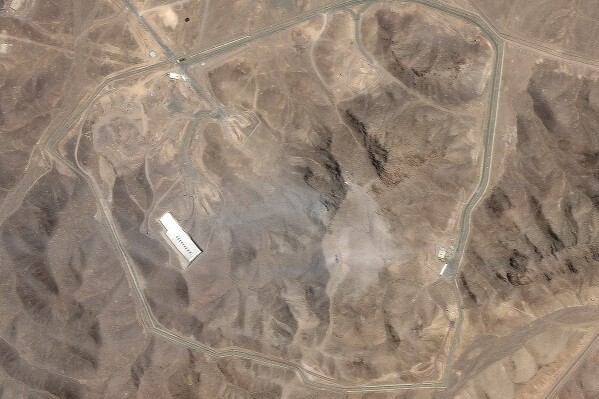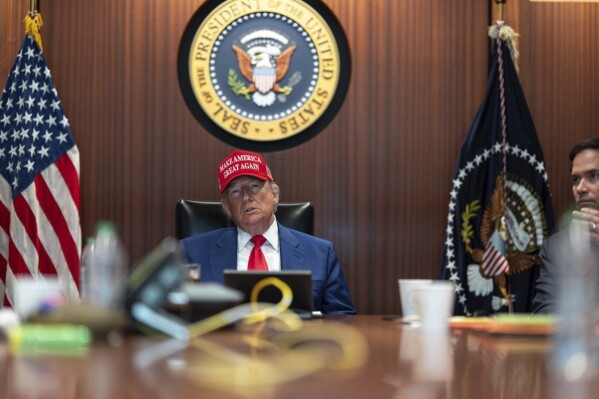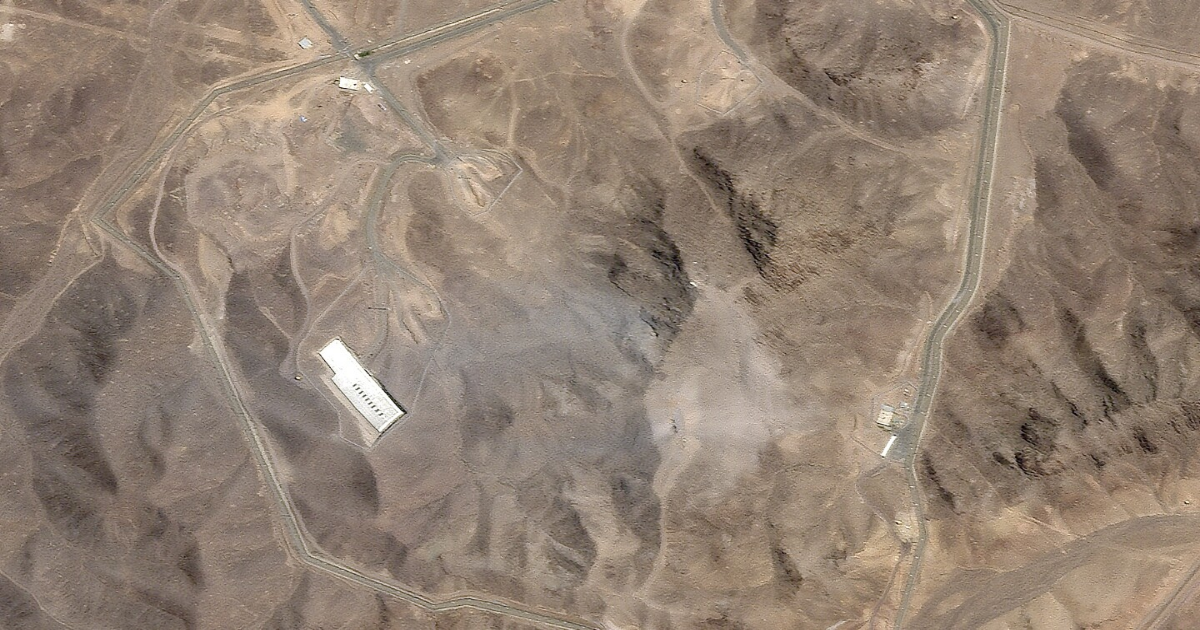Israeli military spokesperson Brig. Gen. Effie Defrin said Israel was still assessing damage from U.S. strikes on Iran’s nuclear sites.
At a press briefing, Defrin was asked whether enriched material had been removed from the Fordo site before the U.S. strike, and he replied that it was too early to know. Defrin said the strikes were carried out in coordination with the Israeli military.
The French foreign minister says his country did not take part in the U.S. strikes against Iran’s nuclear facilities.
Jean-Noel Barrot said in a message on social media on Sunday that France “has learned with concern” of the U.S. military action against three nuclear sites.
“It was neither involved in these strikes nor in their planning,” Barrot said, adding that France “urges the parties to show restraint in order to avoid any escalation that could lead to an extension of the conflict.”
Barrot also reiterated France’s opposition to Iran gaining access to nuclear weapons. “France is convinced that a lasting solution to this issue requires a negotiated solution within the framework of the Non-Proliferation Treaty,” he said. “It remains ready to contribute to this in conjunction with its partners.”
Foreign Minister Abbas Araghchi, responding to a question from a Russian outlet, said he’ll travel to Moscow later on Sunday to meet with President Vladimir Putin, after the U.S. struck Iranian nuclear sites.
“We enjoy a strategic partnership and we always consult with each other and coordinate our positions,” he said, referring to Russia.
Abbas Araghchi told a news conference in Istanbul that there is “no red line” that the U.S. has not crossed in its recent actions against the Islamic Republic.
“And the last one and the most dangerous one was what happened only last night when they crossed a very big red line by attacking nuclear facilities only,” he said.
Abbas Araghchi, speaking to journalists in Istanbul on Sunday, said while the “door to diplomacy” should always be open, “this is not the case right now.”
“The warmongering, a lawless administration in Washington is solely and fully responsible for the dangerous consequences and far reaching implications of its act of aggression,” Foreign Minister Abbas Araghchi said in a news briefing at a conference in Turkey.
These were the first public statements from a high-ranking Iranian official since the U.S. carried out its strikes overnight.
The head of the International Committee of the Red Cross has warned that the escalation in the Middle East risks “engulfing the region — and the world — in a war with irreversible consequences.”
“The world cannot absorb limitless war. Upholding international humanitarian law is not a choice — it is an obligation,” Mirjana Spoljaric said in a statement.
Satellite images taken Sunday analyzed by The Associated Press show damage on the mountainside at to Iran’s underground nuclear site at Fordo after U.S. airstrikes targeted the facility.
The images by Planet Labs PBC show the once-brown mountain had parts turned gray and its contours appeared slightly different than in previous images, suggesting a blast threw up debris around the site. That suggests the use of specialized American bunker buster bombs on the facility. Light gray smoke also hung in the air.

Sealing those entry tunnels means Iran would have to dig out the facility to reach anything inside.
The once-brown mountain had parts turned gray and its contours appeared slightly different than in previous images, suggesting a blast threw up debris around the site. That suggests the use of specialized American bunker buster bombs on the facility. Light gray smoke also hung in the air.
Iran has yet to offer a damage assessment of the site.
CORRECTION: This post has been corrected to show Iran likely sealed up the tunnel entries to Fordo before the Sunday strike by the U.S.
Cabinet minister Jonathan Reynolds told Sky News that Britain was notified as a key ally, though he didn’t know the actual timing. He said the U.S. did not ask for support and Britain was not involved.
“Whilst the British government, the U.K., has not been involved in these attacks, we have been making extensive preparations for all eventualities,” Reynolds said.
He said the government was working on how to look after British nationals as well as its military bases, personnel and infrastructure in the region.
Iran’s Foreign Minister Abbas Araghchi posted on X that the U.S. strikes overnight have blown up any possibility of diplomacy with the Americans or Europeans.
“Last week, we were in negotiations with the US when Israel decided to blow up that diplomacy. This week, we held talks with the E3/EU when the US decided to blow up that diplomacy,” Araghchi wrote on X.
“What conclusion would you draw?” He added that British and European Union comments for Iran to “return” to the negotiating table is unfeasible now.
The island kingdom of Bahrain, in a warning that shows the growing concern in the Gulf Arab states, told drivers to stay off main roads if possible.
Bahrain’s Interior Ministry wrote on X: “In light of recent developments in the regional security situation, we urge citizens and residents to use main roads only when necessary, to maintain public safety and to allow the relevant authorities to use the roads efficiently.”
Bahrain is home to the U.S. Navy’s Mideast-based 5th Fleet and long been a threatened target of Iran.
Iran’s paramilitary Revolutionary Guard says it launched 40 missiles, including its Khorramshahr-4 missile, during the attack on Israel on Sunday morning.
Iran has said the Khorramshahr-4 can carry multiple warheads.
Israel’s military said it bombed two F-5 fighter jets of the Iranian military at the country’s Dezful airport.
The F-5s are part of Iran’s aging fleet of fighter jets from the era of the shah. Israel released black-and-white footage showing one of the aircrafts being destroyed.
Israel previously hit F-14 Tomcats flown by the Iranian military in the war. However, it isn’t clear if these aircraft were airworthy as many have been grounded over the years due to a lack of parts.
Iran has not acknowledged losses of aircraft or other materiel in the war so far.
The Israeli Health Ministry says Iranian attacks overnight and into Sunday have wounded more than 80 people.
The vast majority, more than 70, were lightly wounded, it said.
The head of U.N.’s nuclear watchdog posted on X that given the U.S. intervention in the Israel-Iran war, he will be convening an emergency meeting of the Board of Governors on Monday.
Rafael Grossi, the director general of the International Atomic Energy Agency, has been the target of much Iranian criticism in recent days for what they describe as conflicting statements that incited Israel’s initial attack.
Iranian state TV showed what appeared to be previous test-firing footage of the Khorramshahr-4 missile, with an on-screen caption saying it was used on Sunday in a barrage on Israel.
The Khorramshahr-4 has the heaviest payload of Iran’s ballistic missile fleet, which analysts say may be designed to keep the weapon under a 2,000-kilometer range limit imposed by the country’s supreme leader.
The missile has been described as having a 2,000-kilometer (1,240-mile) range with a 1,500-kilogram (3,300-pound) warhead.
Iran’s Foreign Ministry says “the U.S. has itself launched a dangerous war against Iran” after America attacked three nuclear sites in the Islamic Republic.
“The world must not forget that it was the United States — during an ongoing diplomatic process — that betrayed diplomacy by supporting the aggressive actions of the genocidal and lawless Israeli regime,” the ministry said in a lengthy statement.
It added that Iran “reserves its right to resist with full force against U.S. military aggression and the crimes committed by this rogue regime, and to defend Iran’s security and national interests.”
Israeli first responders say several residential buildings were damaged in an Iranian missile barrage launched after the U.S. strikes.
Moti Nissan, a paramedic with Magen David Adom, described a “large-scale scene of destruction,” with several two-story buildings “severely damaged.” He did not provide a location.
Israeli has sought to conceal the precise location of missile impacts to avoid giving targeting information to the Iranians.
The Magen David Adom rescue service says one of those wounded was a 30-year-old man in moderate condition and the other 10 were lightly wounded.
Shortly after the Iranian missile barrage, Israel announced its warplanes were conducting strikes on “military targets” in western Iran, without immediately elaborating.
Iran says a man accused of spying for Israel has been executed. The case was not previously reported by Tehran.
The judiciary’s Mizan news agency identified the man as Majid Mosayebi and said he was hanged on Sunday after charges of spying in exchange for cryptocurrency payments.
The development raises fears of Tehran stepping up executions in the country in retaliation for the U.S. attacks. Iran is one of the world’s top executioners.
The Houthi rebels in Yemen are vowing to support Iran in its fight against “the Zionist and American aggression.”
Their statement called for the Muslim nations to join the holy war and act as “one front against the Zionist-American arrogance.”
The militant Palestinian group Hamas says the U.S. aid strikers on Iran are a “direct threat to international peace and security”
and “a blind pursuit of the rogue Zionist occupation’s agenda.”
The Israeli rescue service United Hatzalah said it was dispatching first responders. There was no immediate word on casualties or damage.
Iran has fired hundreds of missiles and drones at Israel since Israel launched a surprise attack on its military and nuclear facilities last week. Israel’s sophisticated air defenses are able to shoot down most but not all of the missiles and drones.
U.S. Sen. Chris Murphy posted on X that he and other senators received a classified briefing last week from intelligence officials who indicated that Iran did not pose an immediate threat through its nuclear program.
“Iran was not close to building a deliverable nuclear weapon,” Murphy said. “The negotiations Israel scuttled with their strikes held the potential for success.”
The International Atomic Energy Agency says there has been “no increase in off-site radiation levels” after U.S. airstrikes on Iranian nuclear sites.
The U.N. nuclear watchdog sent the message via the social platform X.
“The IAEA can confirm that no increase in off-site radiation levels has been reported as of this time,” it said. The “IAEA will provide further assessments on situation in Iran as more information becomes available.”
Iran’s ambassador to the United Nations has asked for an emergency Security Council meeting for what he described as the U.S.’s “heinous attacks and illegal use of force” against Iran.
In a letter, obtained by AP, Ambassador Amir Saeid Iravani, said that the U.N.’s most powerful body must “take all necessary measures” to hold the U.S. accountable.
“The Islamic Republic of Iran condemns and denounces in the strongest possible terms these unprovoked and premeditated acts of aggression, which have followed the large-scale military attack conducted by the Israeli regime on 13 June against Iran’s peaceful nuclear sites and facilities,” the letter continued.
Israel’s military says it has identified missiles launched from Iran toward the territory of Israel.
The public has been instructed to go to shelters and protected areas and remain there until further notice.
Iran’s Foreign Minister Abbas Araghchi says on X that Tehran “reserves all options” to retaliate.
He’s the first ranking official to comment on the strikes on Isfahan, Fordo and Natanz by the U.S.
“The events this morning are outrageous and will have everlasting consequences,” Araghchi wrote.
A semiofficial news agency in Iran has published an account attack on Fordo quoting one of its reporters.
Fars, which is believed to be close to Iran’s paramilitary Revolutionary Guard, said its reporter heard anti-aircraft fire around 2:05 a.m. local time. The reporter heard explosions two minutes later, it said.
“When I reached the vicinity of the Mehr-o-Mah recreational complex, the air defense system was operating intensely, and its activity was clearly visible in the sky,” the reporter said.
“At around 2:35 a.m., I arrived near the Mahtab recreational complex. At that moment, amid the air defense activity, flames suddenly erupted from the direction of Fordo.”
Simultaneously with the flames, a faint trail of smoke and a significant amount of dust rose in the area, Fars quoted the reporter as saying. It offered no photos or video showing the attack.
Israeli officials lauded the strikes in sweeping and dramatic language.
Israel’s president, Isaac Herzog, thanked Trump and said the strikes marked a “decisive moment between the axis of terror and evil and the axis of hope.”
Defense Minister Israel Katz congratulated Trump on what he described as a “historic decision.”
The U.S. is stepping up evacuation flights for American citizens from Israel to Europe and continuing to draw down its staff at diplomatic missions in Iraq as fears of Iranian retaliation again U.S. interests in the Middle East grow.
Even before those airstrikes were announced by President Donald Trump on Saturday evening in Washington, the U.S. embassy in Jerusalem announced the start of evacuation flights for American civilians from Israel.
Sixty-seven American citizens left Israel on two government flights bound for Athens, Greece on Saturday and four more evacuation flights to Athens were planned for Sunday, according to an internal State Department document seen by The Associated Press.
In addition to the flights, a cruise ship carrying more than 1,000 American citizens, including several hundred Jewish youngsters who had been visiting Israel on an organized tour, arrived in Cyprus, according to the document.
Israeli strikes on Iran killed at least 865 people and wounded 3,396 others, a human rights group said Sunday.
The Washington-based group Human Rights Activists offered the figures, which covers the entirety of Iran. It said of those dead, it identified 363 civilians and 215 security force personnel being killed.
Human Rights Activists, which also provided detailed casualty figures during the 2022 protests over the death of Mahsa Amini, crosschecks local reports in the Islamic Republic against a network of sources it has developed in the country.
Iran has not been offering regular death tolls during the conflict and has minimized casualties in the past. On Saturday, Iran’s Health Ministry said some 400 Iranians had been killed and another 3,056 wounded in the Israeli strikes.
— This post has been corrected to reflect that the count is for deaths caused by Israeli, not U.S., strikes.
Israel’s Airport Authority announced it was closing the country’s airspace to both inbound and outbound flights in the wake of the U.S. attacks on Iranian nuclear sites.
The agency said it was shutting down air traffic “due to recent developments” and did not say for how long.
Iran said early Sunday there were “no signs of contamination” at its nuclear sites at Isfahan, Fordo and Natanz after U.S. airstrikes targeted the facilities.
Iranian state media quoted the country’s National Nuclear Safety System Center, which published a statement saying its radiation detectors had recorded no radioactive release after the strikes.
“There is no danger to the residents living around the aforementioned sites,” the statement added.
Earlier Israeli airstrikes on nuclear sites similarly have caused no recorded release of radioactive material into the environment around the facilities, the International Atomic Energy Agency has said.
The U.S. military used “bunker-buster” bombs in its attack on Iran’s Fordo nuclear fuel enrichment plant, which is built deep into a mountain, a U.S. official said. That official spoke on condition of anonymity to discuss military operations.
The 30,000-pound bunker-busting American bomb known as the GBU-57 Massive Ordnance Penetrator uses its weight and sheer kinetic force to penetrate underground and then explode. Saturday’s strikes were the first time it has been used in combat.
U.S. submarines also participated in the attacks in Iran, launching about 30 Tomahawk land attack missiles, according to another U.S. official, speaking on condition of anonymity to discuss military operations.
It was not clear what those missiles were aimed at. Two Iranian nuclear sites besides Fordo were attacked, Isfahan and Natanz.
 In this image provided by the White House, President Donald Trump and Secretary of State Marco Rubio, right, sit in the Situation Room, Saturday, June 21, 2025, at the White House in Washington. (The White House via AP)
In this image provided by the White House, President Donald Trump and Secretary of State Marco Rubio, right, sit in the Situation Room, Saturday, June 21, 2025, at the White House in Washington. (The White House via AP)

The White House published photos on X showing President Donald Trump monitoring the Iran mission from the Situation Room.
Trump was joined by his top advisers, including Vice President JD Vance, Secretary of State Marco Rubio, White House chief of staff Susie Wiles, Defense Secretary Pete Hegseth, as well as Dan Caine, the chairman of the Joint Chiefs of Staff.
In one photo, papers in front of CIA director John Ratcliffe appear to be blurred.
Israeli Prime Minister Benjamin Netanyahu said in a video that Trump called him after the strikes: “It was a very warm conversation, very emotional.”
Speaking in Hebrew, he called Trump a friend of Israel like no one before him.
“In my own name, and on behalf of all citizens of Israel, and on behalf of the entire Jewish world, I thank him from the bottom of my heart,” he said.
After Trump spoke to the country about the bombing in Iran, the White House had an eerie calm.
There was darkness outside the West Wing, other than bright TV crew lights and yellow lights from the nearby Eisenhower Executive Office Building overlooking the White House.
A siren rang in the background in city traffic that continued without pausing for the historic moment.
Trump’s speech came on in the overhead speakers in the White House press area, only for his voice to give way to a sudden silence after he thanked God.
 President Donald Trump speaks from the East Room of the White House in Washington, Saturday, June 21, 2025, after the U.S. military struck three Iranian nuclear and military sites, directly joining Israel’s effort to decapitate the country’s nuclear program, as Secretary of State Marco Rubio listens. (Carlos Barria/Pool via AP)
President Donald Trump speaks from the East Room of the White House in Washington, Saturday, June 21, 2025, after the U.S. military struck three Iranian nuclear and military sites, directly joining Israel’s effort to decapitate the country’s nuclear program, as Secretary of State Marco Rubio listens. (Carlos Barria/Pool via AP)
The U.S. president warned during his address that he will not hesitate to strike other targets in Iran if peace does not come quickly in the Middle East.”
There will either be peace or there will be tragedy for Iran, far greater than we have witnessed over the last eight days,” he said.
Trump said that while the nuclear facilities struck by the U.S. on Saturday were the most “lethal,” “there are many targets left.”
“If peace does not come quickly, we will go after those other targets with precision, speed and skill,” he added.
